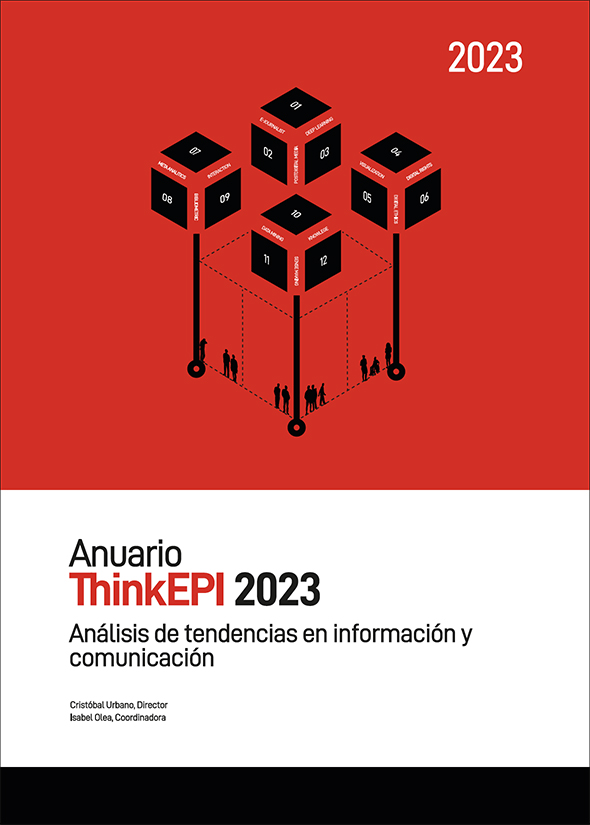Datos abiertos y perspectiva de género, ¿por dónde vamos?
DOI:
https://doi.org/10.3145/thinkepi.2023.e17a33Palabras clave:
Datos abiertos, Perspectiva de género, Sesgo de género, Inteligencia artificialResumen
Los datos abiertos son una innovación tecnológica y conceptual que ha cobrado gran relevancia en los últimos años. Las administraciones públicas, el sector privado y la comunidad científica son conscientes de la utilidad de esta práctica y cada uno desde su ámbito de actuación, la han integrado tanto para abrir los datos como para su reutilización. En vista de la expansión de su uso y del alcance que presumiblemente tendrá en el futuro, es importante preguntarse qué se puede mejorar o en qué no se está acertando. Una de las principales cuestiones pendientes es la inclusión de la perspectiva de género en todas las fases que componen el proceso de apertura de los datos, desde la composición de los equipos de trabajo, pasando por el diseño de recogida de la información, hasta la forma de ponerlos a disposición. Mediante esta nota, se pretende visibilizar la relevancia de la perspectiva de género y por qué este enfoque es necesario para que los datos abiertos saquen todo su potencial y no dejen a nadie atrás, incluyendo su relevancia para hacer frente a los desafíos y oportunidades como los relacionados con la inteligencia artificial. Además, se ofrece información de distintas iniciativas que, siendo conscientes de esta necesidad, han elaborado diferentes recursos para abordar los datos abiertos y la perspectiva de género que pueden ser útiles para inspirar nuevos proyectos y políticas.Descargas
Citas
Barr, Elizabeth; Temkin, Sarah (2022). Gender as a social and cultural variable and health. National Institutes of Health. https://orwh.od.nih.gov/about/director/messages/gender-as-social-and-cultural-variable-and-health
BBC (2018). “El algoritmo de Amazon al que no le gustan las mujeres”. BBC News Mundo, 11 octubre. https://www.bbc.com/mundo/noticias-45823470
Bellver-Fernández, Carina; Ventura-Pocino, Patricia (2022). Les dades obertes i la intel·ligència artificial, eines per a la igualtat de gènere. Generalitat de Catalunya. ISBN: 978 84 18199 49 3 https://upcommons.upc.edu/handle/2117/385310
Berevoescu, Ionica; Ballington, Julie (2021). Representación de mujeres en gobiernos locales: Un análisis global. ONU Mujeres. https://oig.cepal.org/sites/default/files/womens-representation-in-local-government-es.pdf
Biglia, Barbara; Bonet-Martí, Jordi; Luxán-Serrano, Marta; De-la-Fuente-Vázquez, María (2022). Introduint la perspectiva de gènere interseccional a les estadístiques. Guia teoricopràctica. Institut Català de les Dones & Publicacions de la Universitat Rovira i Virgili. https://dones.gencat.cat/web/.content/03_ambits/Observatori/07_estudis_metodologies/publicacions_eines15-1.pdf
Castillo, Dianne (2023). “The gender data gap in AI: Confronting bias in machine learning”. Seldon blog, 28 February. https://www.seldon.io/the-gender-data-gap-in-ai
Data2x; Open Data Watch (2022). Transforming the data landscape: Solutions to close gender data gaps. https://data2x.org/resource-center/transforming-the-data-landscape-solutions-to-close-gender-data-gaps
Datos.gob.es (2022). “Cómo construir conjuntos de datos con perspectiva de género”. Datos.gob.es, 25 noviembre. https://datos.gob.es/es/noticia/como-construir-conjuntos-de-datos-con-perspectiva-de-genero
Datos contra el ruido (2023). Visibilizando las violencias machistas. https://datoscontraelruido.org
Datos x violencia x mujeres (2023). Violencia de género en datos. https://www.datosviolenciamujeres.es
DeepL (2023). About DeepL. https://www.deepl.com/es/publisher
DigitalFems (2023). ¿Qué hacemos? https://digitalfems.org
Educo (2019). “¿Qué es la perspectiva de género y por qué es importante?”. Cuaderno de valores. El blog de Educo, 27 diciembre. https://www.educo.org/blog/que-es-perspectiva-de-genero-y-su-importancia
EPV (2023). APP Anticipate. https://operativatacticapolicial.org/app-anticipate-2
España (2007). “Ley orgánica 3/2007, de 22 de marzo, para la igualdad efectiva de mujeres y hombres”. BOE, n. 71, 23 marzo. https://www.boe.es/buscar/act.php?id=BOE-A-2007-6115
España (2021). “Real Decreto-ley 24/2021, de 2 de noviembre, de transposición de directivas de la Unión Europea en las materias de bonos garantizados, distribución transfronteriza de organismos de inversión colectiva, datos abiertos y reutilización de la información del sector público, ejercicio de derechos de autor y derechos afines aplicables a determinadas transmisiones en línea y a las retransmisiones de programas de radio y televisión, exenciones temporales a determinadas importaciones y suministros, de personas consumidoras y para la promoción de vehículos de transporte por carretera limpios y energéticamente eficientes”. BOE, n. 263, 3 noviembre. https://www.boe.es/eli/es/rdl/2021/11/02/24
European Commission (2021). She figures 2021 gender in research and innovarion: Statistics and indicators. European Commission. https://doi.org/10.2777/06090
Ferrer-Sapena, Antonia; Peset, Fernanda; Aleixandre-Benavent, R. (2011). “Acceso a los datos públicos y su reutilización: Open data y open government”. Profesional de la informacion, v. 20, n. 3, pp. 260–269. https://doi.org/10.3145/epi.2011.may.03
Gencat (2023). Dones i poder local. Participació i poder de les dones a Catalunya. https://dones.gencat.cat/ca/ambits/Observatori-de-la-Igualtat-de-Genere/empoderament/dones_politica
Gender Data Kit (2023). Gender Data Kit. https://genderdatakit.org/esp
Gender data lab (2023). Gender data lab. https://datoscontraelruido.org/genderdatalab
Gobierno de México (2018). ¿Qué es la perspectiva de género y por qué es necesario implementarla? Comisión Nacional para Prevenir y Erradicar la Violencia contra las Mujeres. https://www.gob.mx/conavim/articulos/que-es-la-perspectiva-de-genero-y-por-que-es-necesario-implementarla
Klump, Jens; Bertelmann, Roland; Brase, Jan; Diepenbroek, Michael; Grobe, Hannes; Höck, Heinke; Lautenschlager, Michael; Schindler, Uwe; Sens, Irina; Wächter, Joachim (2003). “Data publication in the Open Access initiative”. Data science journal, v. 5, n. 1. https://doi.org/10.2481/dsj.5.79
La CIBA (2023). DataLab. https://laciba.gramenet.cat/es/recursos/observatori-de-la-ciba/datagenderlab
Ladysmith Collective (2023). Ladysmith. https://ladysmithcollective.com/toolkit
López, A. (2023. November). “¿Niñas desnudas en Almendralejo? Todo lo que se sabe de los montajes eróticos hechos con inteligencia artificial”. El confidencial, 20 septiembre. https://www.elconfidencial.com/espana/2023-09-20/ninas-desnudas-almendralejo-inteligencia-artificial_3738438/
Medicamentalia (2023). Anticonceptivos. https://medicamentalia.org/anticonceptivos
Observatori de Transparència i Dades Obertes (2023). Datos y mujeres. https://ctranspaupv.com/datos-abiertos-mujeres/
Open Data Watch (2021). ODIN open data inventory 2020/21. Executive summary. https://opendatawatch.com/publications/odin-open-data-inventory-2020-21-executive-summary
OpenCorporates (2023). Our purpose. https://opencorporates.com/info/about
Pastor, Javier (2019). “La Apple Card ante el sexismo y la polémica: acusan al algoritmo de conceder a un hombre 20 veces el crédito de su mujer”. Xataka, 11 noviembre. https://www.xataka.com/empresas-y-economia/apple-card-sexismo-polemica-algoritmo-apple-concede-a-hombre-20-veces-credito-su-mujer
The World Bank (2023). Gender data portal. https://genderdata.worldbank.org
Unicef (2017). Comunicación, infancia y adolescencia: Guías para periodistas. Perspectiva de Género. Unicef. ISBN: 978 92 806 4892 8 https://www.unicef.org/argentina/sites/unicef.org.argentina/files/2018-04/COM-1_PerspectivaGenero_WEB.pdf
Unión Europea (2019). “Directiva (UE) 2019/1024 del Parlamento Europeo y del Consejo de 20 de junio de 2019 relativa a los datos abiertos y la reutilización de la información del sector público”. Diario oficial de la Unión Europea, L 172/56, 26 junio. https://eur-lex.europa.eu/legal-content/ES/TXT/PDF/?uri=CELEX:32019L1024&rid=1
United Nations (2016). Integrating a gender perspective into statistics. United Nations. Department of Economic and Social Affairs. https://unstats.un.org/unsd/demographic-social/Standards-and-Methods/files/Handbooks/gender/Integrating-a-Gender-Perspective-into-Statistics-E.pdf
United Nations (2022). The sustainable development goals report 2022. United Nations. Department of Economic and Social Affairs. https://unstats.un.org/sdgs/report/2022/The-Sustainable-Development-Goals-Report-2022.pdf
Unwomen (2023). Incorporación de la perspectiva de género. https://www.unwomen.org/es/how-we-work/un-system-coordination/gender-mainstreaming
Viejo, Manuel (2023). “Decenas de menores de Extremadura denuncian que circulan fotos de falsos desnudos suyos creadas por inteligencia artificial: ‘Me dio un vuelco el corazón’” El país, 18 septiembre. https://elpais.com/espana/2023-09-18/la-policia-investiga-el-desnudo-integral-de-varias-menores-en-extremadura-con-inteligencia-artificial-me-dio-un-vuelco-el-corazon.html
WHO (2018). Gender and health. World Health Organization. https://www.who.int/es/news-room/fact-sheets/detail/gender
Descargas
Publicado
Cómo citar
Dimensions


